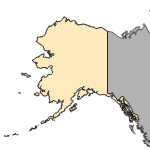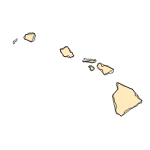Gambusia nobilis
(Pecos Gambusia)
Fishes
Native Transplant |
|
Common name: Pecos Gambusia
Taxonomy: available through
www.itis.gov
Identification: Sublette et al. (1990); Hubbs et al. (1991); Page and Burr (1991).
Size: 4.8 cm.
Native Range: Endemic to springs and sinkholes in the Pecos River system, New Mexico and Texas (Hubbs et al. 1991; Page and Burr 1991).



|

Alaska |

Hawaii |

Puerto Rico &
Virgin Islands |

Guam Saipan |
Hydrologic Unit Codes (HUCs) Explained
Interactive maps: Point Distribution Maps
Nonindigenous Occurrences:
Table 1. States with nonindigenous occurrences, the earliest and latest observations in each state, and the tally and names of HUCs with observations†. Names and dates are hyperlinked to their relevant specimen records. The list of references for all nonindigenous occurrences of Gambusia nobilis are found here.
Table last updated 1/1/2026
† Populations may not be currently present.
Ecology: Prefers clear, vegetated waters in springs and sinkholes.
Means of Introduction: This endangered species was intentionally stocked to create additional populations. Ink Pot and one sinkhole at Bitter Lake were stocked in 1973. The source of the Living Desert State Park population stocked in 1975 is apparently Blue Spring, near Black River Village, Eddy County (U.S. Fish and Wildlife Service 1982b). Pecos Gambusia were transplanted from waters near the north end of the Bitter Lake National Wildlife Refuge into 19 new localities within the same refuge and within the Salt Creek Wilderness Areas in 1972 and 1973. Other sinkholes at Bitter Lake were stocked in July and August 1981 (U.S. Fish and Wildlife Service 1982b). As part of recovery efforts, health officials in New Mexico investigated the use of G. nobilis in stock ponds within the Pecos River drainage to control mosquitoes, but the project was stopped when stocked fish failed to survive (Johnson and Hubbs 1989).
Status: Extirpated at Lake St. Francis and Geyser Spring, Bitter Lake National Wildlife Refuge, probably due to predation by introduced green sunfish Lepomis cyanellus and largemouth bass Micropterus salmoides (U.S. Fish and Wildlife Service 1982b). New populations became established in two sinkholes and at Ink Pot as result of 1972-1973 stockings. The other 16 transplants made at that time failed. Status of 1981 populations not known (U.S. Fish and Wildlife Service 1982b).
Impact of Introduction: The impacts of this species are currently unknown, as no studies have been done to determine how it has affected ecosystems in the invaded range. The absence of data does not equate to lack of effects. It does, however, mean that research is required to evaluate effects before conclusions can be made.
References: (click for full references)
Hendrickson, D. A., and J. E. Brooks. 1991. Transplanting short-lived fishes in North American deserts: review, assessment, and recommendations. Pages 283-298
in W. L. Minckley and J. E. Deacon, editors. Battle against extinction: native fish management in the American West. University of Arizona Press, Tucson, AZ.
Hubbs, C., R. J. Edwards, and G. P. Garrett. 1991. An annotated checklist of freshwater fishes of Texas, with key to identification of species. Texas Journal of Science, Supplement 43(4):1-56.
Johnson, J. E., and C. Hubbs. 1989. Status and conservation of poeciliid fishes. Pages 301-331 in G. K. Meffe, and F. F. Snelson, editors. Ecology and evolution of livebearing fishes (Poeciliidae). Prentice Hall, Englewood Cliffs, NJ.
Page, L. M., and B. M. Burr. 1991. A field guide to freshwater fishes of North America north of Mexico. The Peterson Field Guide Series, volume 42. Houghton Mifflin Company, Boston, MA.
Sublette, J. E., M. D. Hatch, and M. Sublette. 1990. The fishes of New Mexico. New Mexico Department of Game and Fish, University of New Mexico Press, Albuquerque, NM. 393 pp.
U.S. Fish and Wildlife Service. 1982b. Pecos gambusia (Gambusia nobilis) recovery plan. U.S. Fish and Wildlife Service, Albuquerque, NM. iii + 41 pp.
U.S. Fish and Wildlife Service. 1993a. Endangered and threatened wildlife and plants. 50 CFR 17.11 & 17.12. Federal Register, August 23, 1993. U.S. Department of the Interior, Washington, DC.
Other Resources:
Texas Freshwater Fishes - Texas State University San Marcos
Environmental Conservation Online System - U.S. Fish and Wildlife Service
Species Profile: Pecos Gambusia - Texas Parks & Wildlife
FishBase Summary
Author:
Leo Nico, and Pam Fuller
Revision Date: 8/23/2011
Peer Review Date: 8/23/2011
Citation Information:
Leo Nico, and Pam Fuller, 2026, Gambusia nobilis (Baird and Girard, 1853): U.S. Geological Survey, Nonindigenous Aquatic Species Database, Gainesville, FL, https://nas.er.usgs.gov/queries/FactSheet.aspx?speciesID=851, Revision Date: 8/23/2011, Peer Review Date: 8/23/2011, Access Date: 1/1/2026
This information is preliminary or provisional and is subject to revision. It is being provided to meet the need for timely best science. The information has not received final approval by the U.S. Geological Survey (USGS) and is provided on the condition that neither the USGS nor the U.S. Government shall be held liable for any damages resulting from the authorized or unauthorized use of the information.